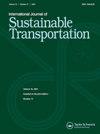Oil tanker emissions: Measurement, factors, and future scenarios
IF 3.1
3区 工程技术
Q2 ENVIRONMENTAL STUDIES
International Journal of Sustainable Transportation
Pub Date : 2025-01-02
DOI:10.1080/15568318.2024.2443819
引用次数: 0
Abstract
This study measured emissions from 76 oil tankers at Eastern Black Sea petroleum terminals to determine their emission factors. Emissions of CO, CO2, NOX, and SO2 were measured during cruise (C), maneuvering (M), and hotelling (H) activities of main engines (ME) and auxiliary engines (AE). Using an activity-based approach, emission factors were calculated from the collected data. Real-time data from 2013 to 2021 were utilized to determine total emissions for each year, while regression analysis forecasted emissions until 2040 under various scenarios. Weighted emission factors for ME were determined as 1.1 ± 0.22 g/kWh for CO, 654 ± 13 g/kWh for CO2, 13.95 ± 2.75 g/kWh for NOX, and 11.45± g/kWh for SO2, and for AE, 1.1 ± 0.21 g/kWh for CO, 706 ± 15 g/kWh for CO2, 15.3 ± 1.4 g/kWh for NOX, and 11.15 ± 2.25 g/kWh. Average load factors were as follows: C (ME): 67%, C (AE): 35%, M (ME): 34%, M (AE): 53%, H (ME): 76%, H (AE): 62%. Total emissions from oil tankers in 2022 were projected to be 235 tons for CO, 151580 tons for CO2, 3018 tons for NOX, and 2251 tons for SO2. Future scenarios indicate these amounts could increase by 3, 5, and 12 times by 2040 under optimistic, normal, and pessimistic scenarios, respectively.
油轮排放:测量、因素和未来情景
本研究测量了东黑海石油码头76艘油轮的排放量,以确定其排放因子。测量了主、辅发动机巡航(C)、机动(M)和制动(H)活动时CO、CO2、NOX和SO2的排放。采用基于活动的方法,根据收集的数据计算排放因子。利用2013年至2021年的实时数据确定每年的总排放量,而回归分析预测了各种情景下到2040年的排放量。ME的加权排放系数分别为CO 1.1±0.22 g/kWh、CO2 654±13 g/kWh、NOX 13.95±2.75 g/kWh、SO2 11.45±g/kWh; AE的加权排放系数分别为CO 1.1±0.21 g/kWh、CO2 706±15 g/kWh、NOX 15.3±1.4 g/kWh、11.15±2.25 g/kWh。平均载客率为:C (ME): 67%, C (AE): 35%, M (ME): 34%, M (AE): 53%, H (ME): 76%, H (AE): 62%。2022年,油轮的总排放量预计为CO 235吨,CO2 151580吨,NOX 3018吨,SO2 2251吨。未来情景表明,到2040年,在乐观、正常和悲观情景下,这些数量可能分别增加3倍、5倍和12倍。
本文章由计算机程序翻译,如有差异,请以英文原文为准。
求助全文
约1分钟内获得全文
求助全文
来源期刊
CiteScore
8.90
自引率
2.60%
发文量
56
期刊介绍:
The International Journal of Sustainable Transportation provides a discussion forum for the exchange of new and innovative ideas on sustainable transportation research in the context of environmental, economical, social, and engineering aspects, as well as current and future interactions of transportation systems and other urban subsystems. The scope includes the examination of overall sustainability of any transportation system, including its infrastructure, vehicle, operation, and maintenance; the integration of social science disciplines, engineering, and information technology with transportation; the understanding of the comparative aspects of different transportation systems from a global perspective; qualitative and quantitative transportation studies; and case studies, surveys, and expository papers in an international or local context. Equal emphasis is placed on the problems of sustainable transportation that are associated with passenger and freight transportation modes in both industrialized and non-industrialized areas. All submitted manuscripts are subject to initial evaluation by the Editors and, if found suitable for further consideration, to peer review by independent, anonymous expert reviewers. All peer review is single-blind. Submissions are made online via ScholarOne Manuscripts.

 求助内容:
求助内容: 应助结果提醒方式:
应助结果提醒方式:


